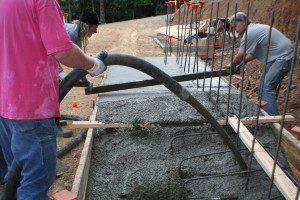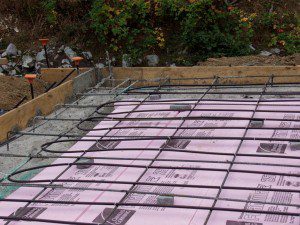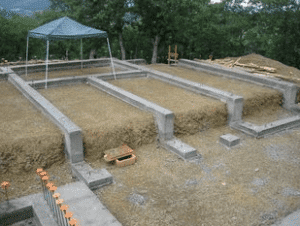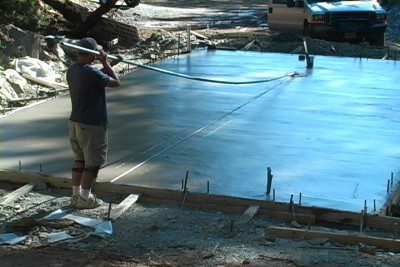Straw Bale Building and the Foundation

In general, foundation systems contain one or more of the following: footings, piers, stem walls, and/or slabs. The two most common systems are slabs and stem walls with footings. Slabs can be very simple and are a great idea when excavation requirements are minimal. Stem walls are especially useful in areas with a deep frost line as more excavation will be required in those situations. Building back with a stem wall may allow you to incorporate a basement in your plan. Be sure to consider the geotechnical engineering requirements of your soil as well. Some jurisdictions actually require a geotechnical report these days, so check with your building department before making any decisions.
Slab on Grade
A floating slab can work in conjunction with basement walls; however, if you are not required to excavate below deep frost lines, a simple, insulated slab on grade will be much more practical. The slab provides for a floor system, foundation system, and heat sink all in one step. Create a heat sink by using materials with high thermal mass in an area that receives direct sunlight.
The sun heats the mass and then over time the stored heat is slowly released into the room. This is one of the major principles of passive solar design. A concrete slab makes for an excellent heat sink. This is also true when using a radiant floor heating system. The large mass of the concrete slab provides for excellent thermal storage, lowering heating costs.
The Downside
As with any material, there are a number of downsides to using concrete. The production of the product itself is very damaging to the environment. Concrete, when used as a new product, has a huge embodied energy (EE) cost. The process of making Portland cement, an ingredient in concrete, creates a 100% embodied energy ratio. In other words, for every one pound of Portland cement, one pound of carbon dioxide is produced. As much waste material as product is created, yielding a 100% EE Ratio.
The addition of rip-rap, old pieces of cured concrete broken up into small slabs, reduces the need for new materials. Minimal amounts of fly ash, incinerator ash, can be added to the mix in place of Portland cement. Some concrete companies do not offer this option, so check it out ahead of time. One thing we know for sure is that the less concrete you use in your project, the more environmentally friendly it will be.
Mind the Details

It is very important to get proper compaction of the sub slab material in order to reduce cracking in the finish slab. Once the slab is formed, leveled, and squared, the installation of the above materials can be relatively quick and easy. For example, a simple 200 square foot slab can be prepared and poured by one person in about 2-3 days. Once poured, as with any concrete, you must wait a minimum of 45 days to allow for proper curing before you begin construction on the concrete. The addition of acid staining or broadcast color is another plus for concrete slabs. The timing of the application of these materials depends on the materials you choose. Broadcast colors are added during the steel toweling. Acid stain is added at the end of the job, after the home is close to completion.
Basement Walls

Waterproof The Basement Walls
Waterproofing the exterior of the basement walls is essential. There are many ways to accomplish this. The following system is economical and provides excellent waterproofing. A waterproof membrane is placed against the foundation wall on the exterior of the building. On top of the membrane, use a sheet drain material to channel water away from the foundation walls. Sheet drains are designed specifically for this and consist of a formed polystyrene board covered on one side with filter fabric. The fabric is placed towards the soils and allows water to flow into the polystyrene board while minimizing the impact of the soils on the system. The sheet drain then wraps around a perforated pipe which carries any water away from the foundation.

To learn how to construct your own concrete slab, click here for more details on our video series.

